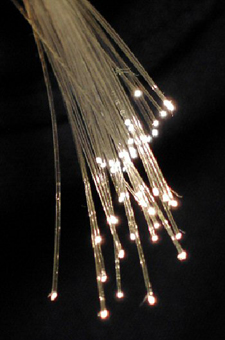
Optical fibers. Courtesy of Wikipedia Commons.
Teasing meaningful information out of a weak signal—whether in a child’s game of “telephone” or an optical network—can be difficult or impossible due to intrinsic noise. Now, scientists at the Joint Quantum Institute (JQI; U.S.A.) have devised a method for lowering the error rate of a quantum system below the standard quantum limit, which could lead to more efficient communications (Nature Photon, doi: 10.1038/nphoton.2012.316).
An ideal, 100 percent efficient receiver can distinguish nonorthogonal coherent states down to a certain minimum level of error probability known as the standard quantum limit, according to Francisco Elohim Becerra, a postdoctoral researcher at JQI, a collaboration of the U.S. National Institute of Standards and Technology and the University of Maryland. Scientists can encode more information into a signal by encoding the data into multiple phases of light, but the higher the number of states or phases, the more difficult it is to distinguish them at the receiver, especially with low-intensity signals.
To “beat” the standard quantum limit, the JQI team devised an adaptive feedback system that makes multiple measurements of the phase of the incoming signal. The receiver uses the first measurement to adjust itself before making the next measurement. The researchers measured the experimental error probability involved in distinguishing between four states in the format known as quadrature phase-shift keying.
The experimental setup incorporated a 633-nm pulsed He-Ne laser to provide the input signal, a 780-nm cw laser to provide the reference signal, a Mach-Zehnder interferometer with beam splitter, single-mode fibers, a single-photon detector and a field-programmable gate array. The experiment yielded error probability 6 dB below the standard quantum limit for an ideal receiver and 13 dB below the limit as adjusted for the 72 percent efficiency of the real detector.
Much more engineering work needs to be done before the technique could be implemented in communications networks, Becerra says. He and his colleagues will study how to implement the technique for more than four states and with other data-carrying schemes such as quadrature amplitude modulation.
